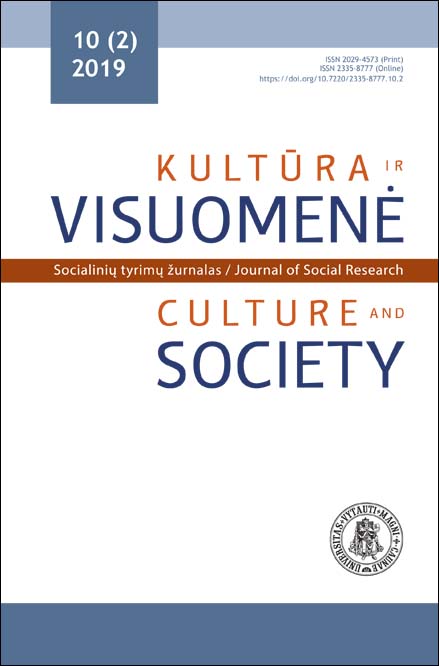Kalba, tautinis tapatumas ir lygios galimybės švietime: mokyklų lietuvių, lenkų ir rusų mokomosiomis kalbomis bendruomenių požiūriai
Language, Ethnic Identity and Equal Opportunities in Education: The Perspectives of Schools with Lithuanian, Polish and Russian Language of Instruction in Lithuania
Author(s): Kristina ŠliavaitėSubject(s): Language studies, Education, Politics and communication, School education, Sociology of Education, Politics and Identity, Identity of Collectives
Published by: Vytauto Didžiojo Universitetas
Keywords: Schools with Lithuanian; Russian and Polish language of instruction; National identity; Native language; State language; Equal opportunities;
Summary/Abstract: The language, ethnic identity and equal opportunities are important dimensions in discussions on minority rights (May 2003, 2012) and this paper focuses on how these issues are seen by informants at the schools with minority (Polish and Russian) and state (Lithuanian) language of instruction in Lithuania. The schools with Lithuanian, Polish, and Russian language of instruction are funded by state and education in national minority language is guaranteed by the Lithuanian laws. The paper focuses on how informants at the schools with different languages of instruction perceive the interrelation between school teaching language, ethnic identity and graduates’ prospects to get enrolled in the university studies. The paper is based on empirical data collected during two research projects. The first research project took place in April 2013 – June 2014 in the localities of Southeastern Lithuania, i.e. in Šalčininkai, Švenčionys, Pabradė, and Eišiškės. The second project was carried out in July 2016 – May 2018 in Vilnius, Kaunas, Klaipėda, and Visaginas. The sites where the research was conducted are multi-ethnic and the schools with Lithuanian, Russian, Polish languages of instruction function there. The interviews were conducted with members of administration and teachers at these schools. At the schools with Lithuanian language of instruction the author conducted 17 interviews, with Polish language of instruction – 9, with Russian language of instruction – 17, with Russian-Polish language of instruction 1 and with Russian-Lithuanian language of instruction – 2. The data are interpreted in the framework of the theoretical perspectives offered by Rogers Brubaker (1996, 2011), Stephen May (2003, 2012), and Will Kymlicka (2000) on the state policies and minority rights, minority-majority hierarchies and relations. The findings are contextualized in the framework of other research conducted in Lithuania on multicultural education (Saugėnienė 2003; Reingardė, Vasiliauskaitė, Erentaitė 2010; Tamošiūnas 2000, 2001 and 2003), school choice and social mobility (Leončikas 2007), and language as a key instrument in the construction of social boundaries and hierarchies between minority and majority groups (Beresnevičiūtė 2005). The author argues that informants at the schools with different languages of instruction construct different narratives on the interrelation of school teaching language and equal opportunities, and they emphasize different instruments of social inclusion. The members of schools with Lithuanian language of instruction support the policies of “nationalizing state” (Brubaker 1996, 2011) by perceiving the Lithuanian language as the main tool for inclusion, integration and social mobility. The majority of informants from the schools with the minority language of instruction emphasize the importance of state language for social integration and equal opportunities, but question it as a single tool in these processes. The informants from schools with Polish language of instruction emphasize Polish language as the main marker of ethnic identity and perceive bilingualism (competences of Polish and Lithuanian languages) or multilingualism (Polish, Lithuanian and Russian) as important for integration in different and particularly in multi-ethnic regions of Lithuania and as enabling studies in Lithuania or Poland. The members of schools with Russian language of instruction emphasize Russian language as the main tool to enable social inclusion and education for pupils from Russian-speaking families, as well as a key element of Russian ethnic identity. However, Lithuanian language is perceived as an important instrument of social mobility as well. The author argues that the perception of bilingualism or multilingualism (competencies of a few languages used by local minorities) as a positive and targeted aim should be promoted not only at the schools with minority languages of instruction, but also at the schools with the state language of instruction. This changing narrative would enable to question symbolic hierarchies among linguistic and social groups (cf. Bourdieau 1991 cited in Beresnevičiūtė 2005; Beresnevičiūtė 2005) and at the same time would address the multi-cultural and multi-ethnic composition of school communities.
Journal: Kultūra ir visuomenė: socialinių tyrimų žurnalas
- Issue Year: 10/2019
- Issue No: 2
- Page Range: 31-58
- Page Count: 28
- Language: Lithuanian

